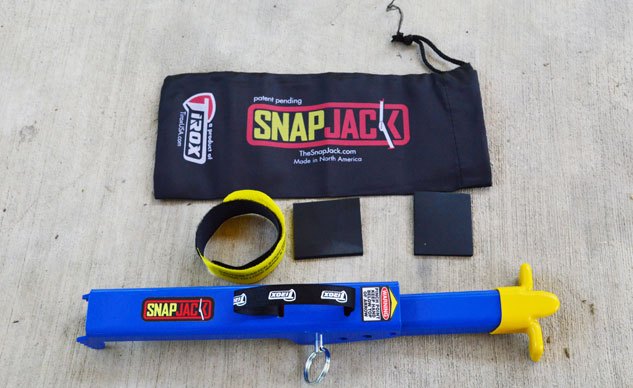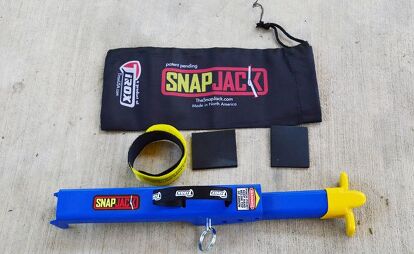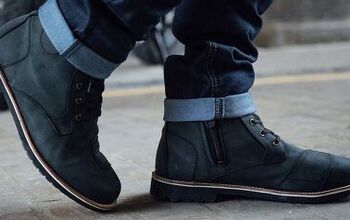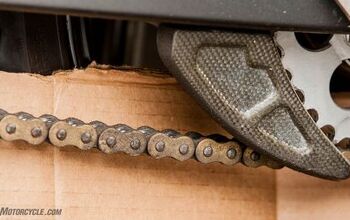MO Tested: TiRox SnapJack

Chain maintenance has never been so simple
On the surface, chain maintenance seems a fairly simple task: lift the rear of the bike, get a rag, some cleaner, some lube, spin the tire a few times (you don’t really turn the bike on and let it idle in gear, do you?) and you’re done. But how do you lift the back tire? Having a rear stand is great, but usually only the sportbike crowd will have one of those. Centerstands also make the task pretty easy, but if you’re one of the many sport-touring, standard, naked, and adventure bike owners, just to name a few, who don’t have either, you’re S.O.L. Besides, even if you do have a rear stand, they take up space in the garage when not in use, and you can’t take it with you on a ride.
That’s where the SnapJack comes in. Every now and again, we come across a product so simple in its design, yet so effective in its intended purpose, we can’t help but ask ourselves, “Why didn’t I think of that?” The SnapJack is one such product. Essentially it’s a scissor jack you place under the right side of the swingarm. Snap it into place and the rear tire sits about a half-inch off the ground – just enough room to spin it and get the chain rolling.
Made from high-strength low alloy steel, the SnapJack weighs slightly more than one pound, and when folded, measures 8.5 inches, making it compact enough to throw in your toolkit next time you go for a ride. Included in each package is the SnapJack, a hook-and-loop brake lever strap, two rubber pads and a carrying pouch.
The first step in using the SnapJack is to place the bike on its sidestand, on level ground with the engine off. This seems obvious but is worth mentioning. From there, take the front brake strap and wrap it around the front brake lever and throttle, ensuring a tight fit so the front wheel doesn’t move. If you’re using the SJ on smooth concrete and/or a painted or epoxy coated garage floor, the two rubber pads will help ensure the floor doesn’t get marked and the SJ doesn’t slip. Place one pad underneath the bike’s sidestand and the other underneath the SnapJack.
From here, a little trial and error is involved as swingarms on different bikes are at different heights from the ground. The SnapJack’s pivot point is adjustable to four different levels by simply removing a cotter pin, moving the arm to one of the four levels, and reinstalling the pin. SnapJack says the lower two settings are appropriate for most sportbikes, while the upper two settings fit most tourers and adventure bikes. In the case of the Kawasaki Versys sampled here, using the third-highest setting was perfect.
With the base of the SnapJack approximately three inches away from the right side of the rear tire, place the cradle underneath the swingarm with the warning label facing you. After that, simply push the SJ until the unit locks into place, making sure to keep fingers and skin away from the pinch point. During this process you can also use your left hand to hold the rear tire in place while pushing the SJ with your right. At this point, if the rear tire spins freely, you’re free to clean/lube your chain or clean your wheel. If the tire doesn’t spin, pull on the release strap just below the pinch point warning label and either reposition the base of the SJ, move the position of the cotter pin, or both. Once everything is finished, pull the release strap to bring the rear tire back to earth, remove the two rubber pads and brake strap, and pack everything back in the pouch. Done.
The SnapJack is a clever and handy little device, that even comes with a lifetime warranty on all its metal parts. For $49.95 there really isn’t a reason not to have one if you own a chain-driven motorcycle. Go to TheSnapJack.com for more information, including where you can buy one. SnapJack also encourages owners to upload videos directly to the site so others can see how SnapJacks are used on a number of different motorcycles. Scroll down to see further illustrations about how the SJ operates.

Troy's been riding motorcycles and writing about them since 2006, getting his start at Rider Magazine. From there, he moved to Sport Rider Magazine before finally landing at Motorcycle.com in 2011. A lifelong gearhead who didn't fully immerse himself in motorcycles until his teenage years, Troy's interests have always been in technology, performance, and going fast. Naturally, racing was the perfect avenue to combine all three. Troy has been racing nearly as long as he's been riding and has competed at the AMA national level. He's also won multiple club races throughout the country, culminating in a Utah Sport Bike Association championship in 2011. He has been invited as a guest instructor for the Yamaha Champions Riding School, and when he's not out riding, he's either wrenching on bikes or watching MotoGP.
More by Troy Siahaan




















































Comments
Join the conversation
Anyone know if these things work on a Ducati Monster with a single sided swing arm? It might be difficult to find a place for the rubber end to get purchase.
Hi, for the Monster and other single sided swingarms, the Snapjack V3 will be coming out soon.
Cheers
Tirox Snapjack